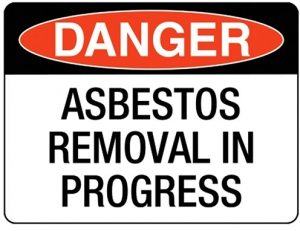What is Asbestos? Asbestos is the name given to a group of naturally occurring minerals that are resistant to heat and corrosion. Asbestos includes the mineral fibers chrysotile, amosite, crocidolite, tremolite, anthophyllite, actinolite and any of these materials that have been chemically treated or altered.
Brief History: Although the use of asbestos dates back to prehistoric times, the mineral came into popularity during the Industrial Age. Asbestos manufacturing was not a flourishing industry until the late 1800s, when the start of the Industrial Revolution helped sustain strong and steady growth of the industry. That’s when the practical and commercial uses of asbestos, with its myriad applications, became widespread.
Is asbestos hazardous? Asbestos is harmful if the fibers become airborne and are inhaled. Fibrous asbestos can fracture into fibers small enough that they can penetrate deep into the lungs, where they can interact with the body to cause cancer or other illnesses. Asbestos-containing materials (ACM) that are intact and in good condition are not hazardous to building occupants under normal conditions.
How might I be exposed to asbestos fibers? Asbestos can enter the environment from weathered natural mineral deposits and fiber releases arising from man-made asbestos products. Asbestos may be found in products like floor tiles; roof shingles; cement; mastic adhesive; automotive brakes and; electrical, plumbing, acoustical, and structural insulation. Asbestos fibers are released into the air when these products are disturbed.
What is my risk of being exposed? Exposure, generally, is during construction where ACM is disturbed to the point of becoming airborne. While asbestos remains in place and non-friable (cannot be easily broken down and made airborne), adverse health effects are unlikely.
What if I’m exposed? If you feel you have been exposed, visit your physician. The most common test used to determine if you have been exposed to asbestos is a chest x-ray. The x-ray cannot detect the asbestos fibers themselves, but can detect early signs of lung disease caused by asbestos exposure. Another tool used by physicians, called a pulmonary function test, can also be useful in identifying lung capacity changes. Periodic health examinations by a physician, including a chest x-ray and review of asbestos-based risk factors, can be effective. Asbestos risk factors include levels, frequency, and length of asbestos exposures; period of time since exposures; and smoking history. The combined impact of cigarette smoking and fiber exposures can increase the chances of asbestos-related lung diseases.
How do I avoid exposure? Pay attention to warning signs around construction sites. Contractors removing asbestos are required to contain these areas so asbestos is not released outside of the work area, to monitor the area for possible exposure, and these areas are to be easily identified with proper signage.
How can I tell if something contains asbestos? It is not possible to visually determine if a material contains asbestos. The presence of asbestos can only be determined by specific sampling and analytical procedures conducted by qualified individuals.
 I have asbestos in my home. Do I need to do anything about it to protect my health? Most of the time, no. The common materials used in home construction are floor tile, roofing and siding. These materials are very strong and don’t readily crumble and release the asbestos fibers unless they are subjected to strong forces. If you never have the need to disturb these materials, you may be able to leave them alone. But if you know that a needed repair or renovation will disturb the material, you may want to start planning with your consultant to abate the asbestos during the project.
I have asbestos in my home. Do I need to do anything about it to protect my health? Most of the time, no. The common materials used in home construction are floor tile, roofing and siding. These materials are very strong and don’t readily crumble and release the asbestos fibers unless they are subjected to strong forces. If you never have the need to disturb these materials, you may be able to leave them alone. But if you know that a needed repair or renovation will disturb the material, you may want to start planning with your consultant to abate the asbestos during the project.
What do commercial property owners/managers have to do with a construction project containing asbestos? There are regulations in place that require owners to know if there is ACM in the building before commencing construction/demolition work. An asbestos survey must be performed and proof of such survey is required in order to obtain the necessary permits. This work is completed by an Asbestos Consultant, such as ERC! If any asbestos is to be removed, a consultant must provide instructions for safe removal (Asbestos Specifications or Design). Additionally, a consultant provides oversight of the removal with onsite monitoring throughout the project.
Is asbestos hazardous? It is the unique physical shape of asbestos that gave it many practical applications and also makes asbestos hazardous. Asbestos is harmful if the fibers become airborne and are inhaled. Fibrous asbestos can fracture into fibers small enough that they can penetrate deep into the lungs, where they can interact with the body to cause cancer or other illnesses. Asbestos Containing Materials (ACM) that are intact and in good condition are not hazardous to building occupants under normal conditions.
If asbestos is so dangerous, why was it even used? Asbestos was so useful because it was incredibly strong and resisted many elements well. It is so strong because of its natural composition. These fibers are extremely durable and resistant to wear. These are the properties making asbestos so attractive for adding to all types of products:
- Inert: That means they have little or no chemical reaction when blended with other materials. This quality makes ACM stable and seemingly safe to handle.
- Non-Flammable: Asbestos materials withstand extreme heat and pressure without breaking down.
- Non-Corrosive: Asbestos fibers don’t rust or corrode when placed in wet and moist conditions.
- Low Thermal Transfer Rate: Asbestos insulation was considered the best material to control heat loss and gain.
- Tensile Strength: Asbestos fibers were enormously strong.
- Lightweight: Some standard products had their weight cut in half when blended with high ratios of asbestos fiber.
- Flexible: Asbestos fibers bend, twist, and turn while maintaining their strength and without giving up other properties.
- Durable: Asbestos fibers do not break down, even when exposed to corrosive ultraviolet rays and acids.
- Readily Available: Asbestos is commonly found in deposits around the world.
- Economical: Because asbestos is common and lightweight, its mining and shipping costs are low. The savings were passed down to the consumer, along with all the other great features asbestos appeared to offer.
When was it realized that asbestos was a health hazard? In the early 1900s, Dr. Hubert Montague Murray at the Charing Cross Hospital in London reported on lung disease in an asbestos textile worker. An autopsy confirmed the presence of asbestos fibers in the worker’s lungs. It was not until 1924, however, that the first case of asbestosis was reported in a medical journal. Documents from the 1930s and 1940s reveal that many asbestos manufacturers were aware of the serious health issues surrounding asbestos, but kept the information secret from workers and from the public. During the 1960s, evidence emerged indicating that asbestos fibers posed a dangerous medical risk. The United States federal government began to regulate asbestos in the 1970s through the Environmental Protection Agency (EPA) and the Occupational Safety and Health Administration (OSHA).
Wasn’t asbestos banned years ago? Only a few asbestos products are banned in the United States. You can still easily buy many asbestos products from the local home improvement store.
 What if I work in a building currently under construction and there are asbestos warning signs? Do not enter the area. Wherever asbestos is being removed (abated) the contractor will put up a containment with warning signs, so any airborne asbestos fibers do not migrate into the occupied areas. This work is strictly regulated and monitored for the safety of the abatement workers, as well as the occupants. Air monitoring is done throughout the abatement to ensure exposure does not exceed a very finite limit set by the Federal Government.
What if I work in a building currently under construction and there are asbestos warning signs? Do not enter the area. Wherever asbestos is being removed (abated) the contractor will put up a containment with warning signs, so any airborne asbestos fibers do not migrate into the occupied areas. This work is strictly regulated and monitored for the safety of the abatement workers, as well as the occupants. Air monitoring is done throughout the abatement to ensure exposure does not exceed a very finite limit set by the Federal Government.
What happens with the ACM that’s removed from buildings? ACM is carefully contained and transported in a sealed container to a hazardous waste disposal site. Because of its features, asbestos never breaks down and remains in these sites forever, unless removed and transported to a different site. The whole process of removal, transportation, and disposal is very tightly regulated.
For more information about asbestos, visit these sites:
Environmental Protection Agency (EPA)
Occupational Safety & Health Agency (OSHA)

